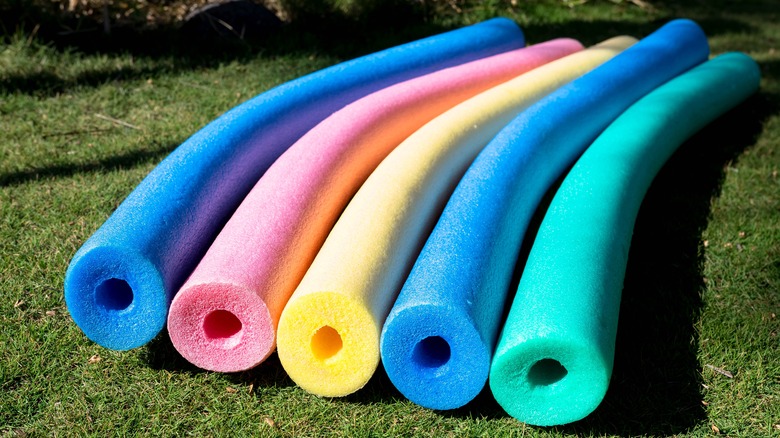Why You Should Line The Edges Of Your Planters With A Pool Noodle
One of the benefits of growing a container garden is that you can cultivate flowers, herbs, and even a huge array of fruit and vegetables on an expansive city patio or small sunny balcony. What green-thumbed city dweller doesn't covet a thriving rooftop garden? Of course, planting in containers has its challenges, not least that the stalks of certain plants — looking at you, cucumbers, vine tomatoes, and strawberries — can hang over the sides of planters.
Thankfully, there's an easy, cheap solution for gardeners that are tired of going to water their potted pumpkin only to find limp, broken branches where thick, healthy stalks once were. Pool noodling your container rims better supports the fragile branches of fruit-laden climbers and hollow-stemmed vegetables like zucchinis than the razor-thin rims of planters, reducing breakages. Therefore, lining the edges of your planter with foam could lead to a larger harvest, as fewer branches will break off or get damaged. This will also work to protect tender indoor vines like pothos or creeping fig, too.
However, while pool noodles are waterproof, they're made from polyethylene foam. This is a synthetic material that doesn't last forever (and by the way, it's not easily recycled). The biggest problem with using a pool noodle in your garden is that sunlight and adverse weather will eventually break down the plastic. To avoid leaching chemicals or microplastics into your soil, replace the noodles at the end of each growing season or sooner if you spot any evidence of deterioration.
The how-to
If you have a pool (or know someone who has one), you might already have access to some retired pool noodles. If not, you'll have to buy them, and you could purchase them at The Dollar Tree, where a 54-inch noodle costs $1.25, or Walmart, which has 50-inch long noodles with a large 3.25-inch diameter for less than $4. As you can see, there are a few sizes to choose from. The wider the diameter, the more cushioning for your plant, and the longer the noodle, the more planter rims you can cover. If you prefer to buy used, try your local charity shops. The rainbow of colors available makes coordinating your planter addition with your existing garden decor easy.
Measure the rim of your planter with a flexible tape measure to determine the length of the piece of noodle you should cut. You can either cover the whole rim or just focus on one section. Using a box cutter or scissors, cut the noodle to the correct size, then slice lengthwise down the noodle to the hollow center. Slip the noodle over the rim and press down until it fits snugly. You can add your DIY stem protector to a planter before potting up the plant or to a pot with something already growing in it. Just be sure to gently tie the stems out of the way until you've finished working. This is one reason why gardeners should have zip ties handy when growing creeping plants.
